
I think it was during a lockdown period in 2020 that we tried watching Great British Sewing Bee (Season 1). I say tried because we didn’t finish the episode. Boring, A pronounced, looking to me for confirmation that he could indeed switch to something more interesting. It hadn’t caught my interest either, so I wasn’t bothered. We laughed and laughed about how daggy* it was, and why would anyone want to go on a show like that?
* Dag/daggy - (Australian slang) for an unfashionable person; a person lacking style or character; a socially awkward adolescent, a 'nerd'. - Australian National University School of Literature, Languages and Linguistics
And then, a few months ago, I was given a free sewing machine via a local Buy Nothing site, an inexpensive Brother that had been in storage and was now unloved, unwanted. Until that day, I hadn’t given any thought to sewing for twenty-plus years, apart from the necessary hems and buttons and seam repairs. A bit of cross-stitch every few years. A rapidly aborted (and sweary) attempt to learn crochet (before I broke my thumb). But the machine was free, and why not add sewing to my quest for a more sustainable, slow lifestyle? I’d probably make a few bowl cosies, tote bags and a pincushion, then store the machine for clothing repairs. Will you make clothes, A asked? No, I said, more confident of my answer than my rusty sewing skills, because my personal history of sewing clothing had proven that this was definitely not my skillset*.
* This statement has since been proven untrue.
My grandmother keeps her sewing bits and pieces in an old Danish Butter Cookie tin (doesn’t everyone in the 1970s and 80s?), her buttons in another. I love sifting through the buttons when I visit, just as I love playing with buttons at home, sorting them into different colours and shapes, marvelling at some of the more unusual buttons. When I become a mother, I will keep my own stash of buttons for my children to play with, and when they leave home, I will save the buttons for my future grandchildren. But I don’t know this yet, because I am nine or ten years old, and I am in my grandmother’s tiny spare room, hand-stitching a long sleeved top from a fabric scrap for my Barbie doll. My stitches are messy, uneven, but my imagination is enthusiastic - my mother, a keen sewer, will be so proud of my skill, and my doll will soon have a whole new collection of clothes. My younger sister will be jealous because she is four years younger and can’t sew dolls’ clothes like I can. Lost in daydreaming, I sew across the neck hole, then throw my imperfect project away in disgust.
I am fourteen, fifteen, reluctantly attending Textiles & Design class at high school. I’d rather be doing Home Economics or Art, but my mum insists I develop good sewing skills. I don’t want to be here, making a lingerie set I’ll never wear. I don’t like the strange green fabric or the modest pattern Mum chose, and I will argue to my end days that it isn’t fair that every other girl has satin. One even has black satin and black lace! The booties I knit for a newborn are the size of a man’s hand. The skirt I make is a sack. The pink fluffy pullover I started to knit is lumpy and hole-y and hidden under my bed. The teacher hates me (and everyone else in the class) and probably wants to be here as much as we do. But I do enjoy embroidery, especially cross-stitching, and I quite like the puff-quilted cushion cover I make. Nonetheless, when Year 10 ends, I switch to Art.
* On examination of my report cards from Years 9 and 10, it appears that I was a “diligent student” - a “pleasure to have in class” - who “achieved a high standard of practical work”. It is therefore probable that the teacher did not, in fact, hate me.
I am twenty-three. I have bought a cheap sewing machine and supplies and I am sewing a puff-quilt cot blanket for the baby I will birth in a few months. I hadn’t expected to want to sew again, and I reason that I am doing this simply to meet some expectation of what a mother should be that I have conceived in my head. I am surprised when I remember how to make the quilt, even more surprised with well it turns out. In two years, I will make another quilt, for another child, but for now, I have made something for my unborn baby, and that feels good. I cross-stitch a cute teddy bear picture, frame it for the nursery wall; I cross-stitch a nappy pin cushion, having decided that I will use cloth nappies despite the trend towards convenience. I start another cross stitch, one for myself, but this is soon packed away in a bag that follows me through several moves over the years, taken out briefly, forgotten much of the time.
I am twenty-seven. Money is tight and I am sewing shorts for my son. I sew the crotch seam the wrong way and the shorts are U-shaped and I can’t do it, I can’t sew, I’m hopeless at it, and that’s it. Years later, I will have no memory of what happened to the unfortunate sewing machine, but I will never forget those darned shorts.
Sewing has always been part of my life. My mother’s sewing machine lived on a table in our back room; I grew up hearing the hum and whirr of the machine, the click-clack of knitting needles, the satisfying snip of scissors on fabric, the tsks of frustration, the sighs of contentment. I learned early on that fabric scissors are for fabric and never, ever under any circumstances for paper, that twenty-minute trips to get groceries could stretch to hours if Mum spotted a haberdashery. I watched with amazement as Mum whipped up crocheted bikinis and tops, sewed quilt covers for our beds, altered clothes, and added embellishments to everything she made. I watched, not knowing that one day, I would give my mother a bundle of calico squares decorated with my sons’ handprints and footprints and drawings, and she would sew them together to make a wall hanging we would see every time we visited. As a child, it seemed there was nothing Mum could not do when it came to textile arts: knitting, crocheting, sewing, appliqué, quilting, tapestry, and more. Even now, wherever she goes, a project (or three) comes along, a necessity for the long Sunday drives she likes. She is always doing something with her hands.
I have inherited that from her.
After I set up the free sewing machine, I sign up for a Domestika course - “Basic sewing with a sewing machine”. I buy fabric (from the bargain bin of a big fabric chainstore) and dutifully follow the instructions to make a drawstring bag. It’s a disaster, the fabric too slippery for my out-of-practice hands. I make another. And another. A suggests making a basket liner for the wicker basket in the laundry, so I find a step-by-step Youtube video, draft a pattern, and several hours later, the basket is dressed. A week later, so is the other wicker basket. I sew a hobo bag, a cross-back apron for my mother-in-law, and make tote bags from charity shop tea-towels and curtain pleat tape. Apart from making the apron, I’m still not making clothes. I download patterns for DIY sandwich covers and snack bags and plate cosies and dice bags.
And then I rediscover Great British Sewing Bee and there’s no going back.
Where did your interest in sewing come from?, I ask my mother. She tells me that her father made clothes on their sewing machine, while her mother hand-sewed. That no one else was allowed to touch her father’s sewing machine. I try to picture it in my head, but come up blank. I remember it being there in the small house he built himself when he emigrated to Australia from Germany in the ‘50s. I remember being told not to touch it. I don’t remember what it looked like. Mum tells me that her first sewing machine was a toy one which didn’t work professionally, but she loved it. She was eight years old.
“I did bits of hand sewing in early primary school but basically taught myself,” she says. “My parents wouldn’t let me do sewing or textiles at school.”
I mull this over. Perhaps this is why she was so insistent that I take sewing classes at school.
My mother bought her first “real” machine when she was 17, just before she married and had me. To her, a woman accustomed to having little, this was a must-have. The brand was Sterling and cost $129 (in 1971) but she asked for a $30 trade-in discount for her toy one. She had this machine for at least 40 years before donating it to charity. In the 1990s, she bought a Pfaff machine and still uses this machine now.
I ask her what she loves most about sewing and she pauses.
“This is a hard one,” she says finally. She loved making clothes, as well as curtains, bedspreads, dolls clothes to keep and sell. She made outfits to wear for weddings, even her own going-away outfit. In my mother’s old photo albums there are photos of me and my sister wearing matching clothes. She finally tells me she likes hand sewing best. An image comes to mind - my mother, by now a single mum, sewing into the night, making clothes on commission for others to sell, doing this to make money so she could keep the house we grew up in, so she could stay off a government pension. She has always been someone who is proud of her ability to make-do to make ends meet. Her ability to find a bargain. To make something old new.
I inherited that from her too.
As well as affirming my desire and move to be part of a more circular economy, Sewing Bee ignites something in me. I find myself watching sewing Reels on Instagram, sometimes inspired, sometimes mesmerised. The algorithm senses this and craftily sends more Reels my way. I buy fabric remnants from charity shops, as well as a few metres of half-price linen from the chainstore. It is not lost on me that the one shop I always tried to divert Mum’s attention from is now the one shop I need to frequent more often. I need elastic, a bias binding maker, cotton batting, more thread, a rotary cutter, a cutting board. My husband thinks this is highly amusing, jokes that I am turning into my mum. In my younger years, I would have been horrified by such a remark - Mum is a wonderful woman, but I didn’t want to be her. Now, I am struck by the fact that I a) have a VIP card for this fabric store and b) I have started sending her “Look what I have made” messages. And then I wait, like a little child, for her approval. Very nice, she texts back. I send her another message. But wait, there’s more.
I upgrade to a new machine - one with an automatic threader and buttonholer that helps when my thumbs and fine motor skills disagree - and pass on my free sewing machine to my son’s girlfriend.
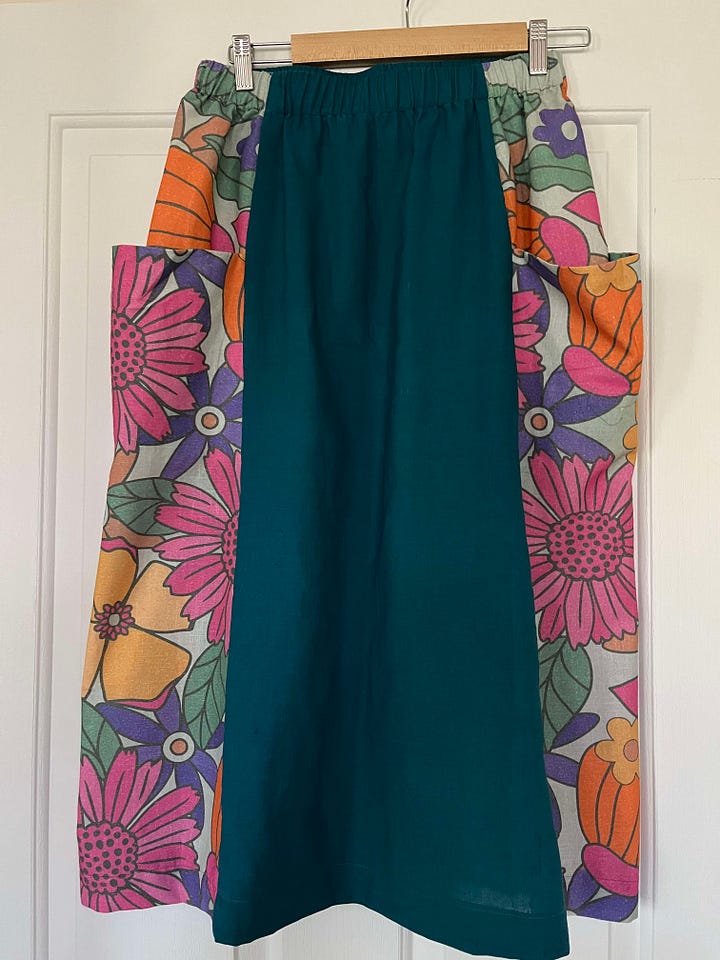
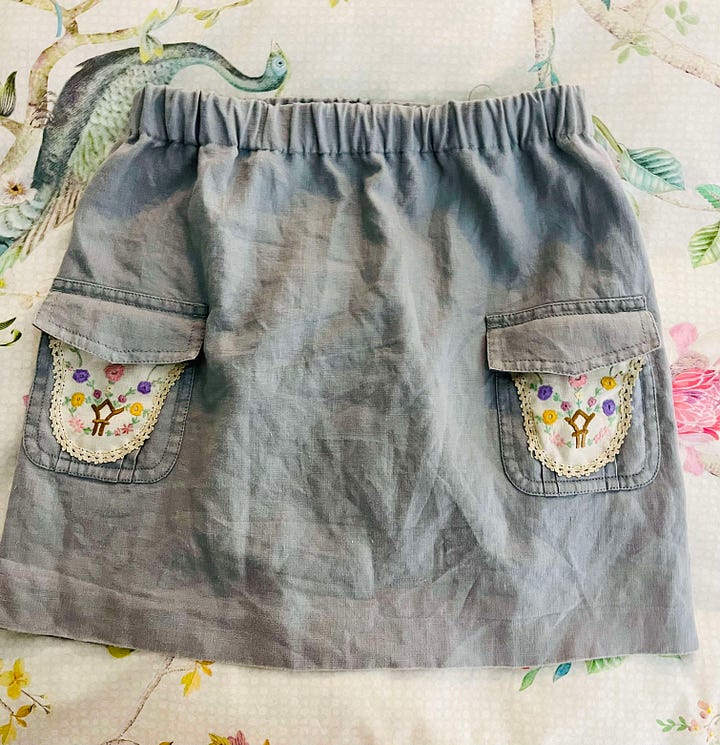
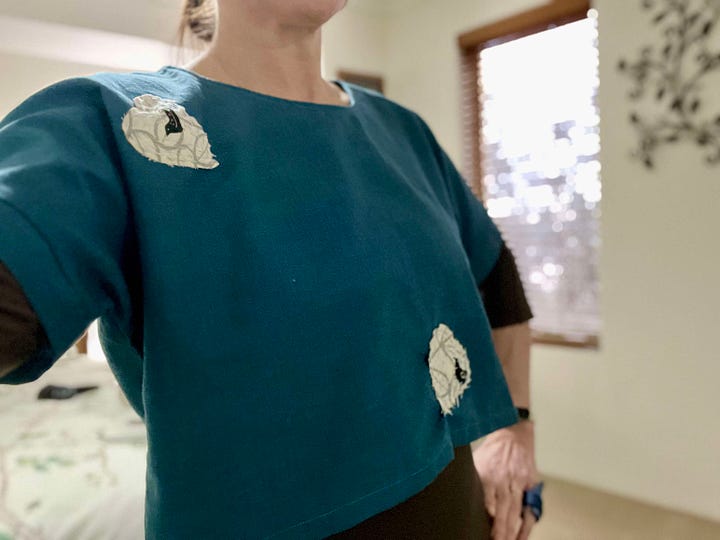
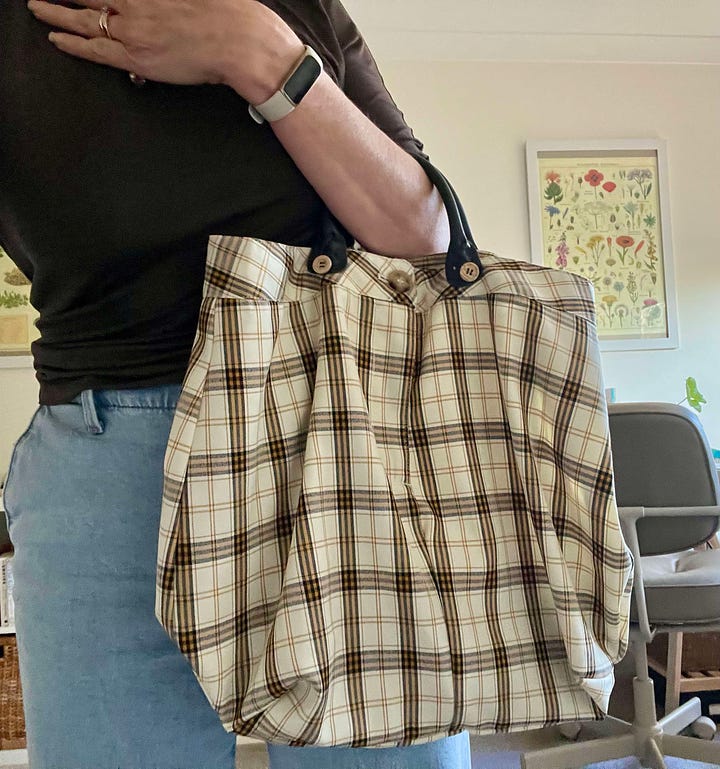
I search for free patterns. I buy a few. I follow a YouTube video to draft my first pattern for a boxy linen tee. I sew the tee. I make bias binding, following instructions on another video. I find out where I can print A0-sized PDF patterns because my hands struggle to piece together multi-piece A4 PDF patterns. I make a skirt, but instead of using one plain piece of linen, I add a floral linen to the side panels. Encouraged by the transformation challenges in Sewing Bee, I look at clothes differently. When I am decluttering the wardrobe, I wonder can I make something new out of that? I experiment - I cut a dress in half and make a lined linen skirt, then appliqué a vintage doily onto the pockets. When I am at a charity shop, I look for fabric or other recycle projects. A blue-and-white linen tablecloth hangs in my art room’s cupboard, waiting to be turned into a dress. For no reason at all, I refashion a short tartan skirt from a charity shop into a bag; the handles come from a Kmart storage box that was going in the bin. I make bookmark pen holders from fabric scraps and another vintage doily - gifts for loved ones at Christmas.
A friend sells me an overlocker (serger) and gives me a lesson. And a pillowcase filled with beautiful fabric from her overflowing stash. A few weeks later, she asks how I’m going with Barbara the Overlocker and I tell her Barbara and I are yet to be properly acquainted. I’m too busy practicing sashiko because this type of sewing, above all others, gives me a sense of peace. I buy a sashiko book and needles; I collect threads from charity shops. I work on another Domestika course - “Introduction to Japanese Sashiko Stitching” - taught by Sashiko Garment Maker Atsushi Futatsuya. I want to learn this properly, not haphazardly; I learn about kasane, which helps make both sides of the fabric look the same. I learn how to draw designs. My thumbs struggle to adapt to correct movement of the needle and the thimble, but Futatsuya encourages me to find my own movement and rhythm. Of all the sewing I am doing, this technique is my favourite. It is meditative, soothing, creative, rhythmic.
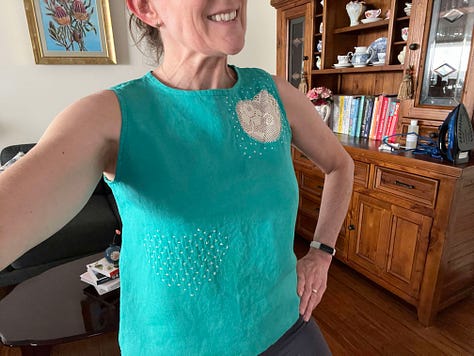
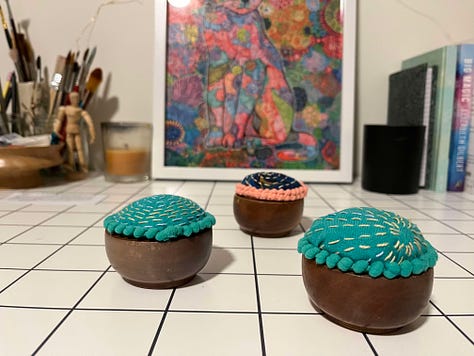

I cut up a linen skirt that never sat right and make pincushions decorated with sashiko for gifts. I sew a linen sleeveless top and use sashiko stitching to decorate it. I cut a heart out of the fabric and use visible mending to add a lace detail.
My creative senses are sparking. I think about sewing when I am at work; I plan to get out the watercolours or to write, but I sit down to sew one thing and the afternoon disappears. I rearrange my art space to make room for my growing fabric stash and supplies, mostly collected from charity stores. I send a photo to my mum.
I suddenly find sewing memes and satire (?) Reels hilarious because that’s me in the corner doing the funny-sewing-things.
Fellow Substacker
invites me to be a guest on her Art Supply Posse podcast. We share many creative loves - writing, photography, painting, sewing. I suspect that her sewing skills are much more advanced. We talk, as if we have known each other for far longer than a couple of months, about “the pressures of productivity versus creativity, and art versus craft … and how all that relates to writing, painting and sewing”. We talk about mental health and the pressures of writing novels. About learning and unlearning. About finding joy in showing up for the small stuff, for what makes me happy right this moment. She encourages me to keep sewing and we laugh about needing patience when tension flares with our machines and we have to unpick yet another mistake.This year, instead of writing another novel, I have focused on what interests me right now. I’m exploring what makes me happy. What gives me joy in the present moment. What slows me down. I am learning to paint watercolour because it teaches me patience - it is good for my creative soul. And I am learning to sew because my creative soul also needs a challenge. To learn something new. To test myself. To see who I really am.
And who I am is this. Someone who finds joy in simple things. I have accepted that I don’t have to write another novel, or win a book prize, or get a film deal or sell thousands and thousands of books to be happy or live a meaningful life. I don’t have to stick to one thing I am good at, to focus all my creative energy on one creative outlet. I have always struggled with the expectation (from myself and peers) that I am a writer, so I need to spend all my spare time writing - like my mum, I like to do a bit of everything. And that’s OK. Exploring what I am curious about is OK.
Learning this, accepting this, has helped me bloom. It is changing me and helping me to move through my days, to live my time in a meaningful, satisfying way - I’m excited to see what new learning and growth is in store for me. A midlife crisis? No, this is midlife discovery. And I’m embracing the journey.
La Muse: Pausing to Wonder is a gift of words and will continue to be free for all readers for the foreseeable future. However, if you feel led (and able) to support my writing financially, there are a couple of options: 1) Buy Me a Coffee, which is a one-time “tip” as a way to say thank you, or 2) subscribe at one of my paid tiers if you wish to provide ongoing support. You can also recommend my Substack to other readers.
Either way, I am grateful that you have chosen to be here today, to be part of my community of readers and writers pausing to wonder (and wander). Let's keep connecting as a community and building each other up.


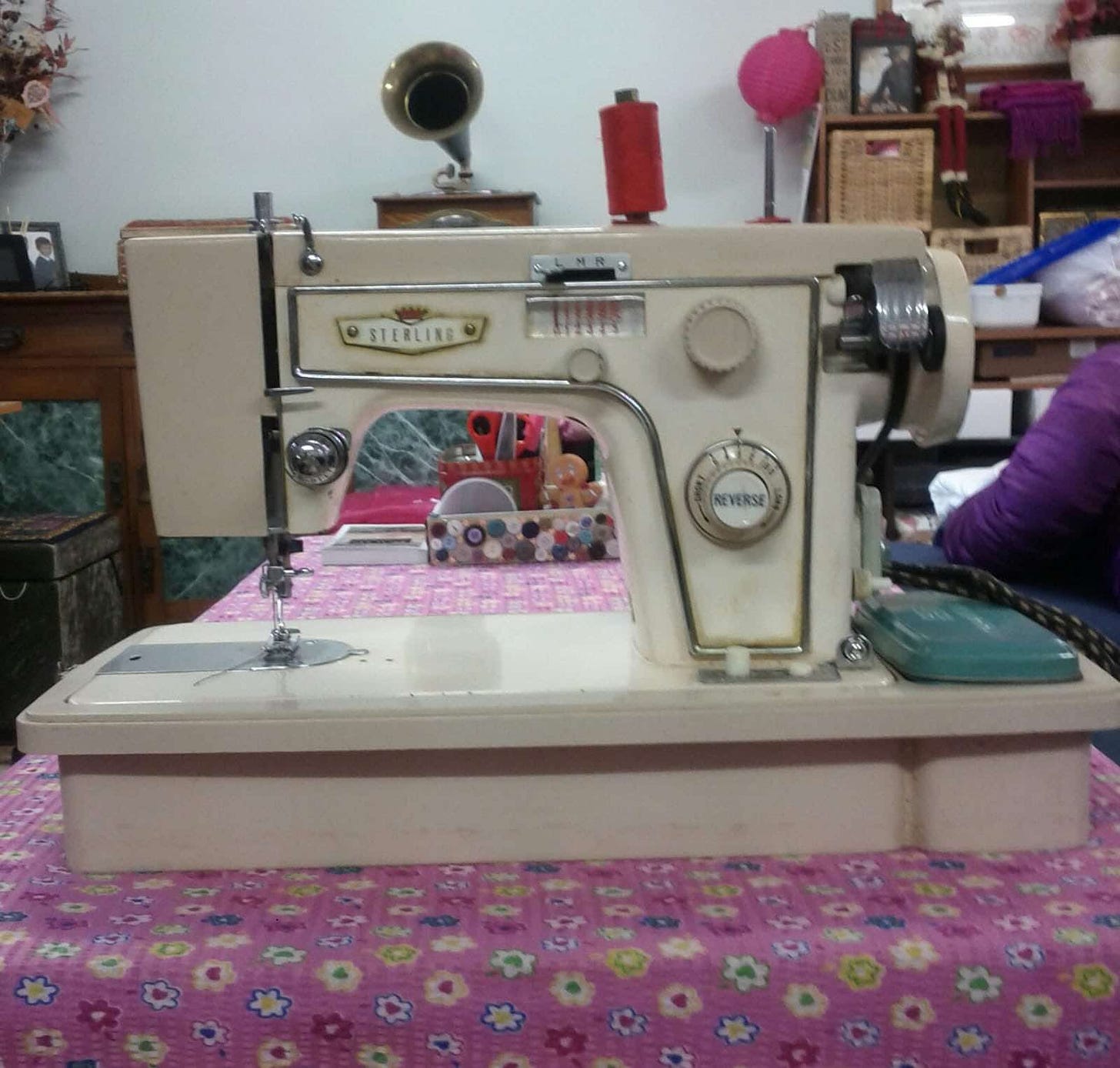
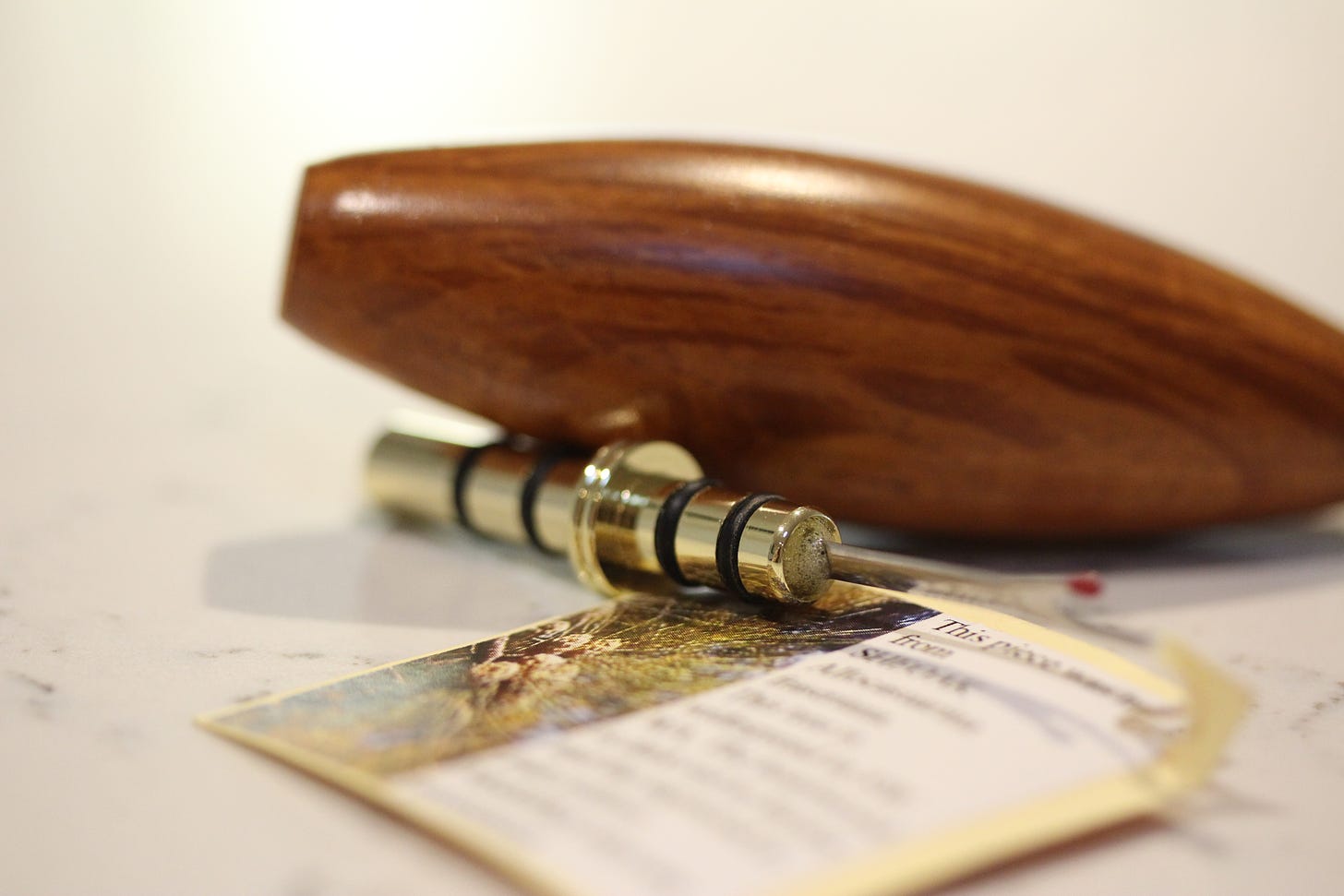



This is so lovely to read Monique .. and chimes on so many levels. Barrie did indeed pop this in my eyeline and I’m very glad he did. For me it’s definitely a midlife discovery .. I have so many projects in mind or on the go! It’s wonderful!
What a journey you and your sewing skills have been on. Look at all you have created! I'm in awe. I just love everything you've dabbled in and shared here Monique. Naturally, I love GBSB too. Even though my skills are complete novice, my enthusiasm is pro. Sending this to my mother in law who like your mother is a lifelong sewing enthusiast.